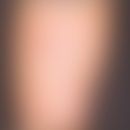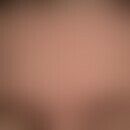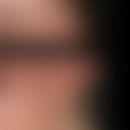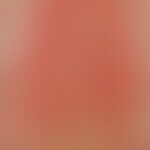Synonym(s)
DefinitionThis section has been translated automatically.
Occurrence/EpidemiologyThis section has been translated automatically.
Urticaria factitia, as well as urticarial dermographism, often occur together with other forms of urticaria. They not infrequently persist after the "accompanying urticaria" has subsided and are then perceived as the only "disease symptom".
You might also be interested in
EtiopathogenesisThis section has been translated automatically.
ClinicThis section has been translated automatically.
DiagnosisThis section has been translated automatically.
Provocation test by firmly scratching the skin on the back or forearm in the form of lines (preferably using a wooden spatula). This provokes various reactions, which can be differentiated according to latency time, duration and itching (see table). The rare intermediate and late types can be preceded by a typical immediate reaction. In cholinergic urticarial dermographism numerous pinhead-sized wheals appear in a striped arrangement instead of a line-like wheal. Familial and cold-dependent urticarial dermographism are also rare.
Differential diagnosisThis section has been translated automatically.
General therapyThis section has been translated automatically.
External therapyThis section has been translated automatically.
Internal therapyThis section has been translated automatically.
- In pronounced cases, the mast cell stabilizer ketotifen (e.g. zadites) shows good efficacy on wheals and itching. Initially 1 mg/day (once/day 1 Kps.) for 3-4 days, then increase to 2 times/day 1 mg and later to 2 times/day 2 mg p.o.
- Non-sedating antihistamines such as desloratadine (Aerius) 5-10 mg/day, cetirizine (Zyrtec) 10 mg/day, levocetirizine (Xusal) 5-10 mg/day can also be used.
- If necessary, use sedative medication at night: Hydroxycin (e.g. Atarax) 25-75 mg/day p.o. or Opipramol (e.g. Insidon) 50-150 mg/day p.o.
- In case of resistance to therapy, an experiment with a pseudoallergen-free diet (no preservatives, colorants or antioxidants) over 4-6 weeks should be carried out, see also Urticaria, chronic.
TablesThis section has been translated automatically.
clinical picture/symptom |
Latency |
Duration |
Itching |
UDG |
Two to ten minutes. |
10-30 minutes. |
- |
UF |
1-5 minutes. |
20-30 minutes. |
+++ |
UDG/UF intermediary type |
30-120 minutes. |
3-6 hours |
- |
UDG/UF delayed type |
4-6 hours. |
24-48 hrs. |
- |
Cholinergic Dermographism/UF |
5-10 minutes. |
20-30 minutes. |
+/- |
Note(s)This section has been translated automatically.
A defined exertion of pressure can be triggered with a standardized dermographometer, the tip of which can be used to trigger a pressure of 10-160g/qmm (HTZ Limited, Vulcan Way, New Addington UK).
LiteratureThis section has been translated automatically.
- Cap JP et al (1985) The effect of ketotifen in Urticaria factitia and Urticaria cholinergica in a crossed double-blind experiment. Dermatologist 36: 509-511
- Butcher M, grave J (2004) Physical urticaria. dermatologist 55: 344-349
- Kontou-Fili K et al (1997) Physical urticaria:classification and diagnostic guidelines. Allergy 552: 504-513
- Juhlin L et al (1987) Inhibiting effect of cetirizine on histamine-induced and 48/80-induced wheals and flares, experimental dermographism and cold-induced urticaria. J Allergy Clin Immunol 80: 599-602
- Termeer C et al (2015) Chronic spontaneous urticaria- A treatment path for diagnosis and therapy in the practice. JDDG 13: 419-429
Incoming links (8)
Dermographism, cholinergic; Dermographism, urticarial; Omalizumab; Pressure urticaria; Skin writing urticaria; Urticaria dermographic; Urticaria factitia tarda; Urticaria physical;Outgoing links (19)
Antihistamines, systemic; Antioxidants; Bamipin; Cetirizine; Clemastine; Dermographism, urticarial; Desloratadine; Dimetinden; Dyestuffs; Gels hydrophilic; ... Show allDisclaimer
Please ask your physician for a reliable diagnosis. This website is only meant as a reference.





